Tagasaste – the number one tree in the permaculture handbook

They grow fast, fix nitrogen, feed bees and stock, withstand extreme storms and droughts, and help other seedlings grow. Nelson Lebo explains why tagasaste is the permaculture practitioner’s best friend.
Words: Nelson Lebo Photos: Brad Hanson
There has been a book on our shelf for decades – a thin, green book, thick with information. I suppose it’s among the core treatises of permaculture, but that’s clear given its title: Permaculture Plants.
Written by Jeff Nugent and Julia Boniface and first published in 1996, the book serves as a comprehensive resource for permaculture practitioners, listing the best flora they can grow to achieve holistic and abundant land management. Tellingly, the very first tree that’s mentioned is tagasaste (Chamaecytisus palmensis).
THE PIONEERS
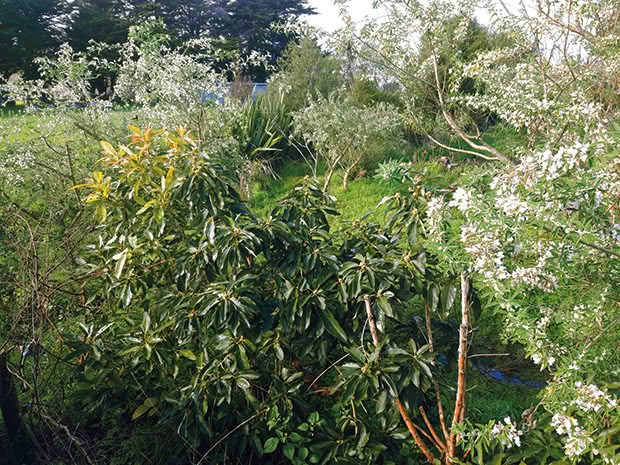
Tagasaste sheltering juvenile avocados from frost and sunburn.
The first section of the book is called The Pioneers, and it lists 11 other plant species alongside tagasaste, also known as tree lucerne. Pioneer species are those that first grow in an area after a disturbance such as fire, wind storm, slips or land clearing. They are characterised as being fast-growing, nitrogen-fixing and short-lived. Additionally they tend to be prolific seed producers. Tagasaste ticks all the boxes.
Native to the Canary Islands where it grows on dry volcanic slopes, tagasaste are capable of reaching heights of seven metres, although typically only grow to three or four. The tree responds well to regular pruning and can be shaped to nearly any form. Cut branches can be fed to livestock or used as mulch in a chop-and-drop fashion. Our goats go crazy for the soft, long branches that can be fed out year-round.
In the southern hemisphere, tagasaste flowers prolifically from late winter/early spring up until November. This is a critical time of year for bee fodder, although kererū also love the abundant blossoms. We have witnessed our muscovies happily devouring the flowers on any low branches they can reach with their outstretched necks. The seed pods dry out and turn black in January and February and can easily be harvested and saved for planting or reportedly fed to chooks – although we have not done so.
HOLISTIC APPROACH
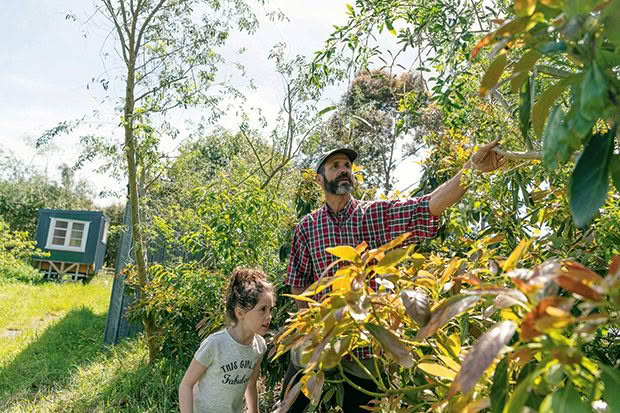
Nelson and Verti inspecting the tagasaste on his block.
Like it or not, owning a lifestyle property makes each of us a land manager or custodian to one degree or another. For better or for worse, we can have significant influence over the health and resilience of our land.
In many ways, tagasaste and other pioneer plants can help us think more holistically about our land and its long-term management.
This is because they act as nurse trees, providing shade and shelter for slow-growing trees, crowding out grasses and providing mulch from leaf litter. Once the slow-growing, long-lasting trees reach maturity, they crowd out the pioneer species, which either die out or become a minor part of the system.
As the book says: “We can simulate this succession by planting out pioneers on to bare land or pastured areas and streamline the reclamation process. The longer-term trees that we choose will become the succession plants.”
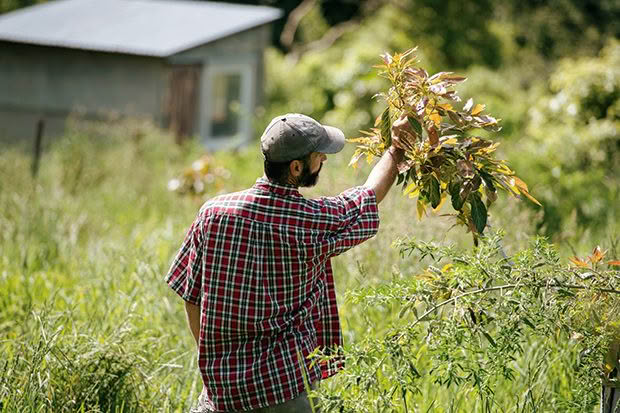
Avocados with tagasaste in the foreground.
This theory mirrors our approach to managing gorse – from the same family as tagasaste – as a vital first step in ecological succession, which we explored in the March 2022 issue of NZ Lifestyle Block. Although gorse regularly and easily establishes itself throughout New Zealand, like tagasaste, it can be used as a nurse tree to shelter and nurture longer-term growth before becoming redundant.
Pioneer plants, from this perspective, are a means to an end rather than an end themselves. They act as a catalyst to accelerate natural biological progression suited to the location. We plant these trees with the understanding and expectation that they will die. We will more than likely outlive them but the succession trees will most certainly outlive us.
For those of us who want to start or progress our journeys toward ecological and resilient land management there can be no better tutors than the pioneer species. They teach us patience and help us develop a vision of what our land can be.
HOW TO GROW TAGASASTE? MAKE A CUP OF TEA
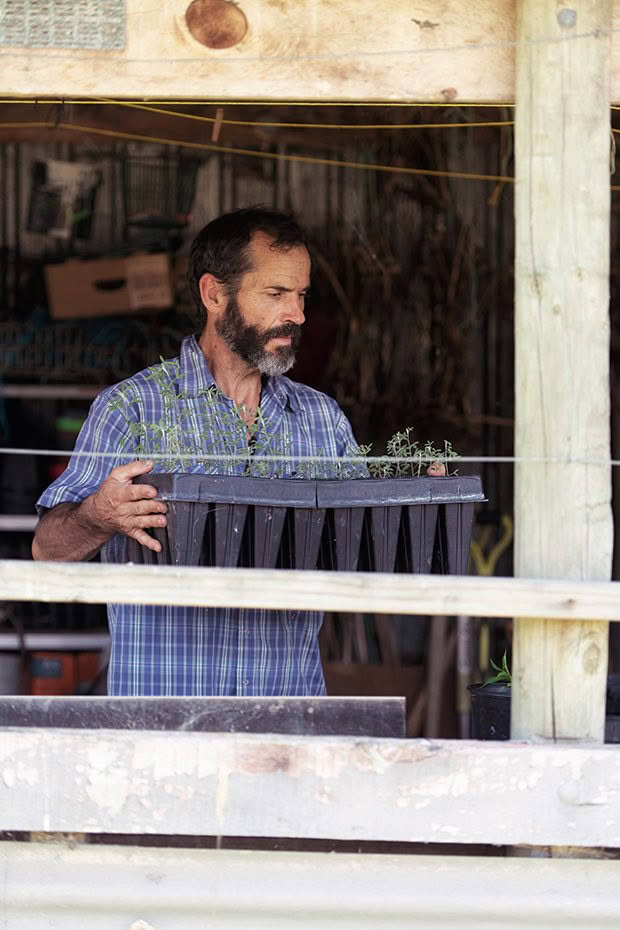
Nelson with tagasaste seedlings. The trees can reach two to three metres in 18 months.
Over the years I’ve had inquiries from people struggling to get the seeds of tagasaste to germinate. We’ve found that it can be – quite literally – as easy as fixing a cup of tea.
The recipe for success is to remove the seeds from the pod and place them in a teacup.
1. Boil a jug and fill the cup to about ¾. Place a saucer over the top and let it stand overnight.
2. On the following day, scatter the seeds in trays of seed raising mix covered to a depth of about 5mm. Keep the medium moist but not damp.
3. When the seedlings are about 5cm tall, prick them out and pot them up in root trainers or tall pots filled with potting mix. Again keep the medium moist but not damp.
4. The young plants will grow quickly although time of year and hours of daylight will have a significant effect on their progress. It’s best to plant them out during winter after they have reached a height of 5cm.
ALL THE USES FOR TAGASASTE

• Green fodder – sheep, cattle, goats, pigs, horses, deer, ostrich, emu, and rabbits
• Shade and shelter
• Wind and water erosion control
• Increased soil fertility through nitrogen fixing
• Reduction in water tables causing salinity problems
• Habitat for native birds and exotic birds some of whom eat pests
• Food for native wood pigeon – you may find they have stripped all the leaves
• Green firebreaks
• Winter nectar for bees
• Reduced internal parasite problems when used as fodder
• Mature trees provide quality firewood with a very high heat content of 10910 MJ per cubic metre. It has basic wood density of 619kg per cubic metre
For more information visit the NZ Tree Crops Association website.
THE PIONEER SPECIES
Other pioneer species listed in the book include: tree lupine, wattles, casuarina, rosewood, alders, black locust, honey locust, and ice cream bean. Of those, we have had experience with tree lupine and casuarina. Beware, some pioneer species are so good at pioneering that they can become naturalised pests (ie, invasives) in some areas.
Tree lupine (Lupinus arboreus)
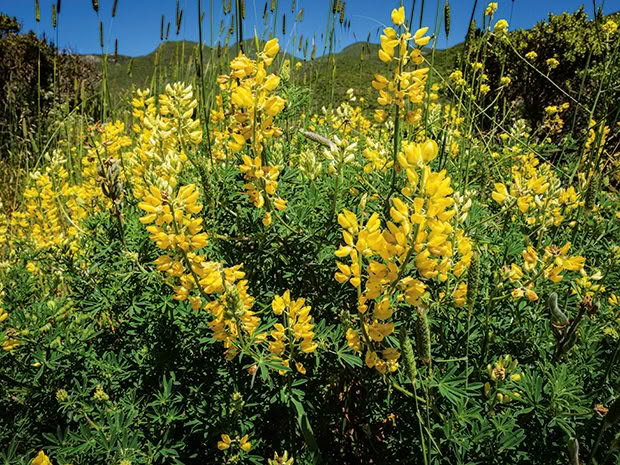
Native to California, this nitrogen fixer is common in coastal New Zealand as it loves deep loose soil such as sand. At our previous home in Castlecliff, Whanganui, tree lupine popped up everywhere and covered the dunes of Castlecliff domain. In winter we regularly walked the dunes to “harvest” snails to feed to our muscovy ducks and red shavers.
River sheoak (Casuarina cunninghamiana)

Native to eastern and northern Australia, river sheoak is the tallest of the Australian casuarinas. It can be used for windbreaks, although we’ve planted 100 of them alongside cabbage trees and carex grasses to help stabilise stream banks within our riparian corridor. We top them in winter, both to manage their height and to feed to our goats over the fence.
It’s reported to be an excellent firewood and can be used to make tool handles. Because ours are planted at the bottom of our steep property we won’t bother using them as the firewood but I’d be keen to have a go at making tools the next time I break a rake.
Love this story? Subscribe now!
 This article first appeared in NZ Lifestyle Block Magazine.
This article first appeared in NZ Lifestyle Block Magazine.
